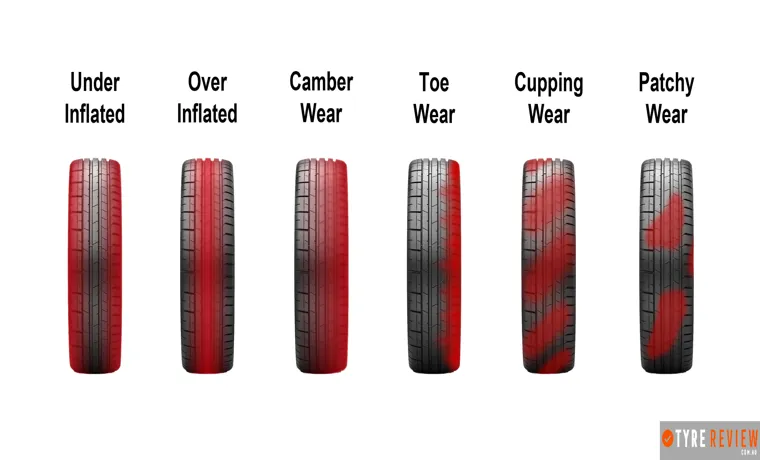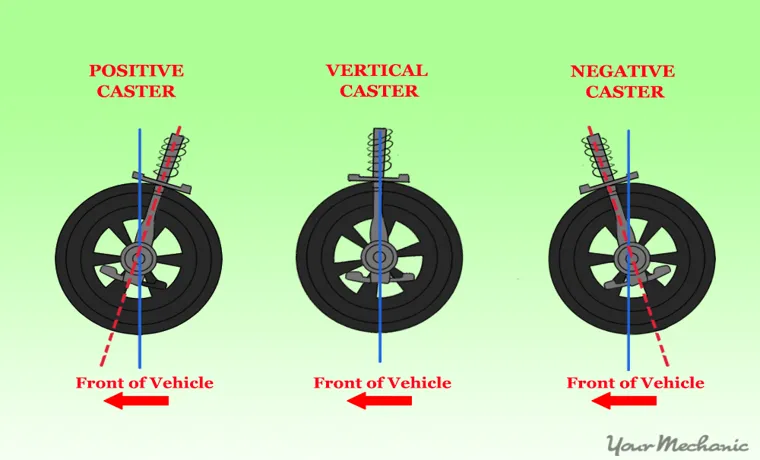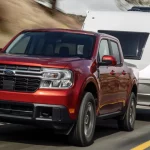Do you ever wonder why your tires wear out unevenly? You might have noticed that some areas of your tire wear out faster than others, causing it to have an uneven surface. There are several factors that can contribute to tire wear, but one of the most common causes is the alignment angle of your wheels. When your car’s wheels are not set at the correct angle, it can cause your tires to wear out prematurely, but which angle causes inner or outer wear? In this blog post, we will discuss the relationship between alignment angle and tire wear and what you can do to prevent it.
Table of Contents
Understanding Alignment Angles
When it comes to alignment angles, the one that is most likely to cause either inner or outer tire wear is the camber angle. Camber is the angle between the vertical axis of a wheel and the plane of the tire. If the top of the tire tilts inward toward the center of the vehicle, it is called negative camber, and if it tilts outward away from the center, it is positive camber.
Both types of camber can cause uneven tire wear, with negative camber causing wear on the inside edge of the tire and positive camber causing wear on the outside edge. It’s important to have your alignment checked regularly and adjusted as needed to prevent premature tire wear and ensure optimal vehicle handling and performance. Don’t ignore any signs of uneven tire wear, such as vibration or pulling to one side, as they can lead to poor handling and even accidents on the road.
Camber Angle
Camber angle is one of the most important alignment angles that determine how your vehicle’s wheels are positioned. This angle measures the tilt of your wheels when viewed from the front or back of your car. Positive camber angle refers to wheels that tilt outward, while a negative camber angle indicates that they tilt inward.
The purpose of camber angle is to ensure the optimal contact patch of your tires on the road. When your wheels have a proper camber angle, they can maintain better grip and stability, especially when cornering. However, if your camber angle is off, you may experience uneven tire wear, steering issues, and poor handling.
Therefore, it’s essential to have your camber angle checked and adjusted by a professional mechanic to ensure that your vehicle is performing at its best.

Toe Angle
Toe angle is a significant aspect of your car’s wheel alignment that can have a significant impact on your vehicle’s handling and tire wear. This angle is determined by the angle your car’s tires make with the centerline axis of the vehicle when viewed from above. The toe angle can either be positive, negative, or zero depending on whether the tires are pointed towards or away from each other or whether they are parallel to each other.
Positive toe angle occurs when the front of the tires point towards each other, while negative toe angle happens when the front of the tires point away from each other. Zero toe angle, on the other hand, occurs when the tires are entirely parallel. To maintain proper toe angle, regular checkups should be carried out by a professional mechanic.
Improper toe alignment can reduce tire life, decrease fuel efficiency, and negatively affect the performance of your car on the road. So, be sure to check your vehicle’s toe angle to avoid unexpected mechanical issues and ensure your car is safe to drive.
Caster Angle
Caster angle is an important alignment angle that determines how stable and easy a vehicle is to steer. It refers to the angle formed by the steering axis and the vertical plane when viewed from the side of the vehicle. It’s an angle that impacts several aspects of the vehicle’s performance, including steering, handling, cornering, and stability.
The caster angle helps keep the vehicle steering straight ahead without wandering, providing better directional stability and easier steering. When this angle is set correctly, the steering wheel will return to its straight-ahead position after being turned, making it more natural to steer. Overall, the caster angle is crucial for a vehicle’s handling and stability, and it’s important to make sure it’s properly adjusted during alignment.
Types of Tire Wear
When it comes to tire wear, there are a few different types that can occur. One of the most common types is inner or outer tire wear, which can be caused by a misalignment of the wheels. Specifically, the camber angle is most likely to cause this type of wear.
If the angle is tilted too far inwards (negative camber), the inner edge of the tire can wear down faster, while a tilt outwards (positive camber) can cause the outer edge to wear down faster. It’s important to keep an eye on your tires and get regular alignments to avoid uneven wear and extend the life of your tires.
Inner Tire Wear
Inner Tire Wear When it comes to tire wear, there are a few different types to be aware of. One of the most common is inner tire wear, which occurs when the inside of the tire tread wears down faster than the outside. There are a few different factors that can contribute to inner tire wear, including improper alignment, overinflation, and worn-out suspension components.
If left unchecked, inner tire wear can lead to reduced driving stability and increased risk of blowouts. That’s why it’s important to keep an eye on your tire wear and address any issues as soon as they arise. Regular tire rotations and alignments can help prevent inner tire wear and keep your vehicle running smoothly.
Remember, your tires are one of the most important components of your vehicle, so be sure to give them the attention they deserve.
Outer Tire Wear
Outer Tire Wear Tire wear is a natural occurrence that happens over time as we drive our vehicles. It is essential to keep an eye on the wear and tear of your tires to ensure they are always in good working condition. Outer tire wear is one of the types of tire wear that you need to be aware of.
This type of wear happens when the outer edges of the tires get worn out more than the center parts. It is usually caused by overinflation, underinflation, or even poor wheel alignment. Overinflated tires tend to have less traction on the road, leading to more wear and tear on the outer edges.
Underinflated tires, on the other hand, tend to flex more, leading to more wear on the outer part of the tires. Poor wheel alignment also leads to outer tire wear since the tires will be angled slightly, causing the outer edges to wear out faster than other parts. Regular inspection of your tires and ensuring they are properly inflated and aligned can help prevent outer tire wear.
So always keep an eye on your tires and address any issues promptly to ensure your safety on the road.
Alignment Angle and Tire Wear Relationship
When it comes to tire wear, the alignment angle that is most likely to cause either inner or outer tire wear is the camber angle. The camber angle refers to the inward or outward tilt of the wheel when viewed from the front of the vehicle. If the top of the tire tilts outward, it is said to have positive camber, and if it tilts inward, it has negative camber.
Both positive and negative camber can cause uneven tire wear, but in different ways. Positive camber can cause outer tire wear, while negative camber can cause inner tire wear. This is because the tire is not making full contact with the road surface, leading to uneven distribution of weight and pressure on the tire.
Therefore, it is important to have your camber angle checked regularly and adjusted if necessary to prevent premature tire wear and extend the life of your tires.
Camber Angle and Tire Wear
Camber angle is an important aspect of your vehicle’s alignment that can significantly impact tire wear. Camber angle refers to the angle between the vertical axis of the wheel and the perpendicular plane of the road’s surface. If your vehicle’s camber angle is not within the manufacturer’s recommended specifications, it can cause uneven tire wear.
A negative camber angle can cause the tire’s inside edge to wear faster than the outside edge, while a positive camber angle can affect the outside edge. This can cause your tires to wear out faster and can also affect your vehicle’s handling and stability. Therefore, it is important to ensure your car’s alignment is correct and within the manufacturer’s specifications to protect your tires and ensure a safe driving experience.
Toe Angle and Tire Wear
Toe angle plays a significant role in determining the wear of your tires. Essentially, toe angle refers to the angle between your car’s tires as viewed from above. If the front edge of the tires points inward towards the car’s centerline, it’s called “toe-in,” and if it points outwards, it’s called “toe-out.
” A toe alignment that is not properly adjusted might lead to uneven wear and tear on your tires. Misaligned toe angles can cause your car to pull to one side and damage the tires’ tread over time. Additionally, improper toe adjustments put undue stress on the suspension and steering components, and can cause them to wear out prematurely.
If you notice excessive tire wear or your vehicle pulling to one side, it’s crucial to get a wheel alignment check done at a reputable auto service center and correct the toe angle to restore the optimal functioning of your car.
Caster Angle and Tire Wear
Caster angle refers to the angle of the steering axis when viewed from the side of the vehicle. It plays a crucial role in the stability and handling of a vehicle. However, caster angle also affects tire wear.
When the caster angle is not aligned properly, it can cause uneven tire wear. This is because the tire is not in contact with the road consistently and wears out on one side. The treads of the tire will become smooth and bald on one side, while the other side remains intact.
To correct this, it’s important to get the caster angle checked and adjusted if necessary. Regular maintenance and alignment checks can help prevent tire wear and prolong the life of your tires, saving you money in the long run. So next time you get your alignment checked, don’t forget to have the technician check the caster angle too.
Your tires will thank you!
Conclusion
In the never-ending battle between inner and outer tire wear, it seems that the alignment angle that is most likely to cause either one is…
drumroll, please…
misalignment! Yes, that’s right, if your wheels are out of alignment, you’re setting yourself up for some serious tire wear issues. But fear not, my intrepid road warriors, with regular maintenance and proper alignment adjustments, you can keep your tires healthy and happy for many miles to come. So go forth, and keep your wheels pointed in the right direction!”
FAQs
1. What are the common causes of inner tire wear?
Inner tire wear can be caused by misalignment, worn suspension components, improper tire inflation, or driving on rough roads.
2. How can you tell if your tires have outer wear?
You can visually inspect your tires for signs of outer wear, which appears as bald spots or uneven tread wear on the outer edges of the tire.
3. What is the recommended alignment angle for preventing tire wear?
The recommended alignment angle for preventing tire wear is a neutral or zero alignment angle, which evenly distributes the weight on the tires and reduces stress on the inner and outer edges.
4. How often should you get your alignment checked to prevent tire wear?
It is recommended to get your alignment checked every 6,000 miles or every six months to prevent tire wear and promote optimal tire performance.
5. Can driving habits affect tire wear?
Yes, driving habits such as aggressive driving, high-speed driving, and hauling heavy loads can affect tire wear and increase the likelihood of inner or outer tire wear.
6. What is camber and how does it affect tire wear?
Camber refers to the inward or outward tilt of the wheels and can affect tire wear by causing either inner or outer wear if not properly adjusted.
7. Is tire rotation important for preventing inner and outer tire wear?
Yes, tire rotation is important for preventing tire wear by evenly distributing the wear across all four tires and prolonging the life of the tires.



